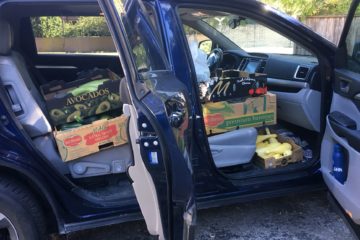Introduction
Most of us, whether we want to admit it or not, enjoy eating processed and fast foods. Burgers, fries, chips, and the occasional frozen pizza or dinner are oftentimes the kinds of foods we find comfort in, tossing away the kale salad for a satisfying combo of carbs and fats. But we know these kinds of foods are supposed to be a treat, not an everyday thing—for fear of being scolded by your doctor at your yearly checkup. For the most part, we’re told that we should be eating a variety of nutrient-dense foods, avoiding added sugars and saturated fats, and limiting our sodium intake. As the old adage says, “an apple a day keeps the doctor away!”
But what happens when you can’t get any fruits or vegetables because the nearest supermarket or grocery store is over a mile away? Driving usually isn’t an option for urban residents, taking Muni or Bart is often wildly inconsistent, and walking can take up to an hour round trip – carrying heavy bags of groceries. Particularly for elderly residents, accessibility and transportation pose a significant barrier.
Those of us with ready access to affordable and nutritious foods often take this privilege for granted. Whether it be meats, fruits, or vegetables, the ability to purchase these types of healthy foods from supermarkets, local grocery stores, or farmers’ markets is largely dependent on geographic location and the socio-economic composition of one’s neighborhood.
In affluent or even middle-class neighborhoods, healthy food options are both plentiful and abundant. In low-income and majority minority neighborhoods, access to a supermarket may require taking several buses or trains. In these same neighborhoods, there is often an overabundance of unhealthy foods which puts the residents of these neighborhoods at a higher risk for obesity, type 2 diabetes, cardiovascular disease, and other diet-related conditions.
It is clear that access to affordable and nutritious foods has a significant impact on long-term health outcomes, but particularly for children, not having enough healthy foods can have serious implications for a child’s physical and mental health, academic achievement, and future economic prosperity.
What are “Food Deserts” and “Food Swamps”?
Several areas in and around San Francisco’s Bayview-Hunters Point, Ocean View, and Tenderloin neighborhoods are marked either green or orange on a map produced by the US Department of Agriculture. These areas are considered “food deserts” which are large geographic areas where there is limited access to fresh, healthy, and affordable food. Access to healthy foods is closely tied to cost of living, vehicle availability, availability of public transportation, racial composition, and the cultural appropriateness of available foods. In San Francisco, where the cost of living is high, transportation accessibility is low, and neighborhoods are culturally diverse, there is limited access to healthy and nutritious foods.
Food deserts typically occur alongside “food swamps” which are areas where fast food, junk food, convenience stores, and liquor stores greatly outnumber healthy food options. Big-chain supermarkets often have a hard time turning a profit in low-income areas, which results in a lack of access to healthy food options. Although many communities in food deserts have access to healthy foods, the issue is that unhealthy processed foods from fast-food restaurants and convenience stores are significantly more accessible.
Bayview Hunters Point, one of the food deserts listed above, has the highest rates of obesity in San Francisco with less than five percent of food sold in the neighborhood consisting of fresh produce. Until 2011, the neighborhood had no chain supermarkets until a Fresh and Easy store was opened—Bayview-Hunters Point’s first new grocery store in 20 years—though this store has now closed due to its parent company’s financial difficulties.
According to the San Francisco Food Bank, roughly one in five San Franciscans each day has no reliable source of fresh foods and must rely on food from soup kitchens, food pantries, or other community resources that have become a structural part of the city’s food system. Outside of these limited options, San Franciscans have limited means to purchase fresh, healthy foods.
In fact, the Center for Disease Control and Prevention’s (CDC) California Action Guide on Fruits and Vegetables found that in California, only “13.6% of adults meet the daily fruit intake recommendations and 11.2% of adults meet the vegetable intake recommendations.” According to further research done by the Hellman Foundation, a Bay Area philanthropy organization, these numbers are likely lower in low-income communities where about 20% of households surveyed reported no weekly purchases of fruits and vegetables.
Imagine having to get all of your groceries from a gas station or local corner store where your selections are limited to chips, frozen pizza, and freezer meals, among other processed foods. Over time, a lack of access to healthy foods leads to a higher risk of contracting dietary-related illnesses such as diabetes, obesity, and heart disease. In turn, this perpetuates the cycle of food insecurity and chronic disease prevalent in low-income neighborhoods—exacerbating already existing racial and ethnic disparities. Given the exorbitant housing and living costs associated with living in San Francisco, food insecurity, while disproportionately affecting low-income neighborhoods, affects a large number of households across the city.
What can we do?
Addressing the public-health problem of food deserts and food swamps requires addressing both the symptoms and root causes of food insecurity. A single action designed to address a specific problem is not likely to produce effective long-term change. Adequately addressing food deserts and food insecurity requires a comprehensive and holistic examination of local food systems.
City programs such as the HealthyRetailSF Pilot, which helps corner stores and convenience stores in food deserts make the switch to selling more fruits and vegetables, have helped to make healthy options more accessible for local residents. These kinds of small investments go a long way towards incentivizing small business owners to sell fresh produce and healthier foods in their stores—making healthy alternatives available to residents in food swamps.
Local governments can also use their authority to address zoning issues and help to encourage the development of supermarkets and other stores that sell nutritious, affordable foods. For example, zoning and land use laws could be revised to explicitly allow supermarkets and grocery stores; allow the use of land or provide permits for farmers’ markets or community gardens; or explicitly prohibit the development of fast-food restaurants within certain areas. By approaching zoning laws with food insecurity in mind, local governments can greatly improve the accessibility and affordability of healthy and nutritious foods.
Community gardens are one way for residents in food deserts to improve their access to healthy foods. A study conducted by researchers from the University of California and Santa Clara University on food insecurity in San Jose found that people who maintained a garden in their yard or a community garden nearly doubled their vegetable intake—meeting the number of daily servings recommended by the U.S. Dietary Guidelines. A similar study by researchers from UCSF found that residents in neighborhoods with community gardens consume a greater amount of food and vegetables because of increased affordability, accessibility, freshness, flavor, and convenience.
In San Francisco, the Recreation and Parks department currently supports and manages 42 Community Gardens located across the city. Volunteers can grow produce and other plants for personal use. To find a garden near you, check out the Community Gardens Interactive Map. There are also nonprofit organizations based in the City such as Urban Sprouts and Planting Justice that manage community gardens in various locations.
At Each Green Corner, we help community members and local schools turn their unused yard space into sustainable gardens and urban farms. By using the diverse resources and interests of community members, our garden plots provide access to fresh produce as well as education on nutrition, health, and sustainable gardening. It is our mission to bridge the gap between home gardeners and food distributors to increase the accessibility of fresh, healthy, and culturally-diverse produce throughout our local communities.
Written by Casey Wu, Grant Writing and Development Intern



0 Comments